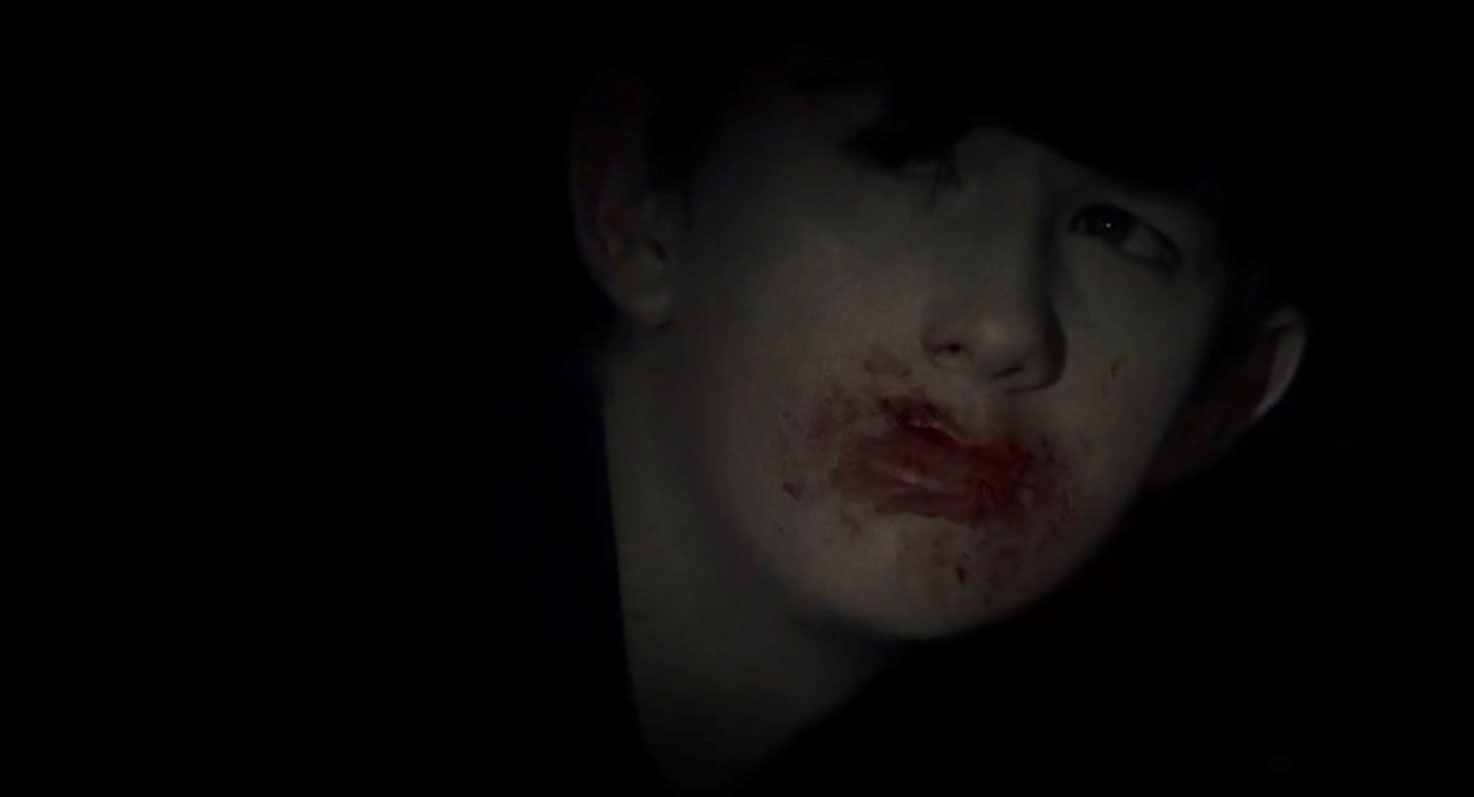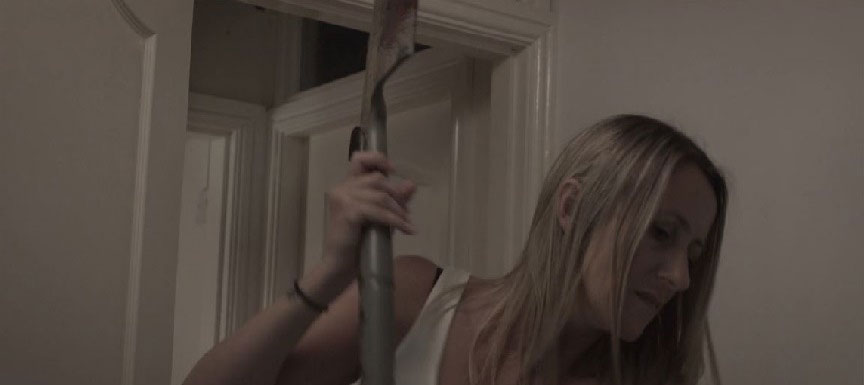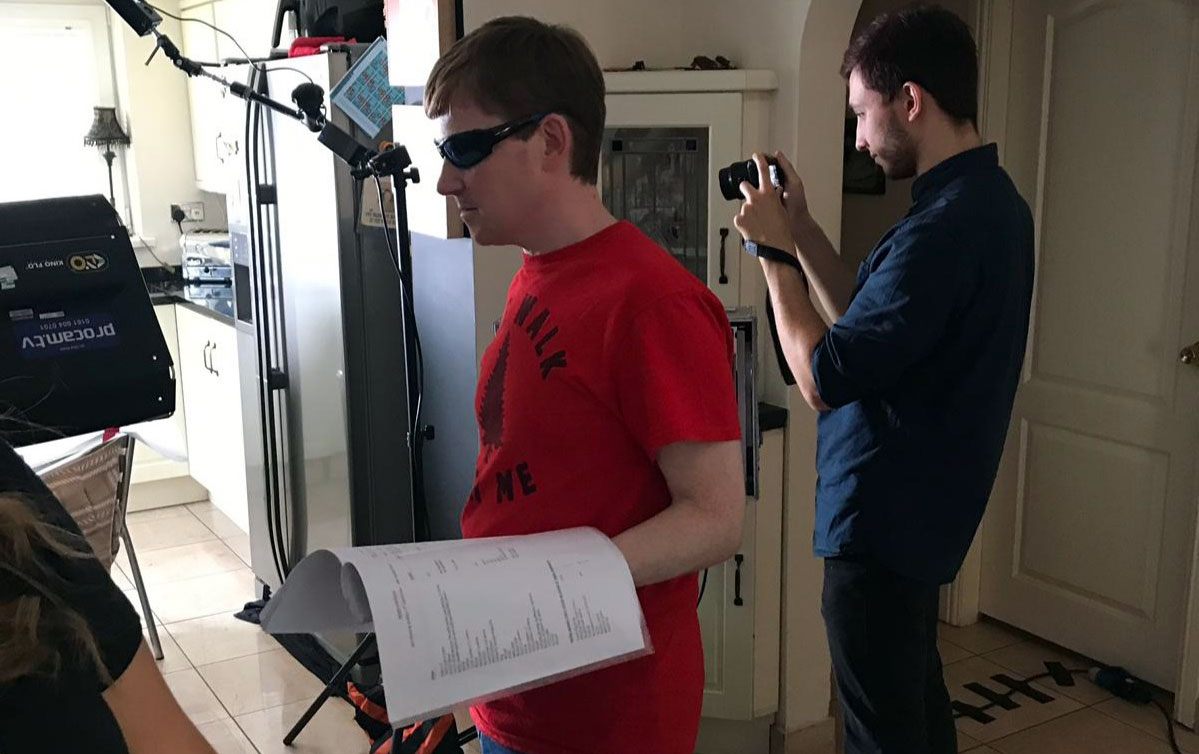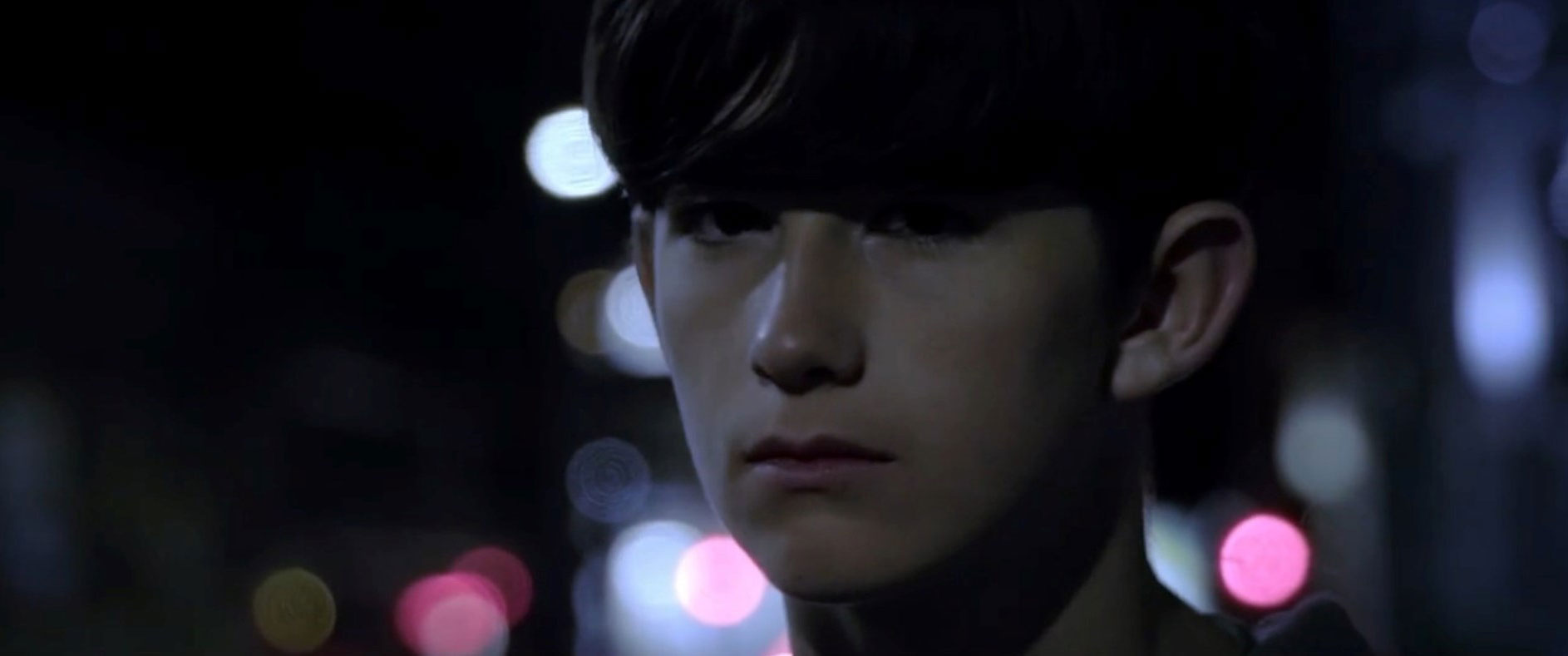
Finding new blood in the vampire genre is Eric Ian Steele, writer and director of Boy #5. A short, sharp, shocking tale of vampirism in Manchester, this is for horror fans who like their chiller cinema genre-bending and filled with memorable characters and performances. Receiving its World Premiere at the Arrow Video FrightFest this August Bank Holiday weekend, Boy #5 marks Steele as a filmmaker of genuine promise. And is a bloody, good watch.
We caught up with Steele to discuss the film, plus moviemaking on a budget, and the three vampire movies you really need to see.
CLICK HERE FOR BOY #5’s FRIGHTFEST SCREENING TIMES AND TICKET INFORMATION
Rob Daniel: To begin, could you tell us a bit about yourself?
Eric Ian Steele: (laughs) Erm. I’m Manchester born and bred. I’ve been writing now for over ten years professionally. I was always a screenwriter and novelist really, then gradually gravitated toward directing. Met the right people, and dabbled with being on set for a few years watching others do stuff at a local cinema group. A chance then came to do my own short film, which we did. Then a very torturous route to making a first feature.
RD: How would you describe Boy #5 to audiences?
EIS: Boy #5 is a vampire film that’s not a vampire film. It’s about a social worker called Marjorie, who has had a traumatic experience with a previous boy in her care. She’s assigned to Nathan, a homeless lad who’s been found on the streets. He’s very shy and withdrawn, but slowly she gets him to open up about himself and they bond emotionally. Unfortunately for Marjorie, it turns out Nathan’s a mutant vampire and things get worse from that point on.
RD: What inspired you to make the movie?
EIS: Originally, we were thinking of making a completely different film. A much bigger crime drama based in Manchester, that we’d got the rights to. We were planning this for ages, and it was getting bigger and bigger, and eventually I realised we needed to do something before we tackled that. Hence Boy #5 was born, something we could do that was contained and on an extremely low budget, with just a few actors. That was the idea behind it, but this small side project then took on a life of its own.
RD: So the crime drama is based on a book?
EIS: Yes, its by a local author, but was put on the backburner because we spent so long on Boy #5. Then COVID happened which put it back on the backburner, so currently it’s right at the back of the oven somewhere!
RD: Boy #5 is an intimate story that stands or falls on its lead performances. Lennon Leckey and Laura Montgomery Bennett are both fantastic in the film, how did you come about casting them?
EIS: We found them at auditions we did locally. We were auditioning for a completely different project and had this great turn out of about 70 actors on the night. Laura and Lennon stood out from the others in the sheer natural quality they both had. Everything Laura does is just so believable. Lennon is fantastic as well, for his years he is terrific. They’re both first time actors and they really clicked on screen, fortunately for us.
RD: I saw Boy #5 was the only credit they both have on IMDb, so was going to ask if this really was their debut movie. Laura brings a warm naturalism to Marjorie, and Lennon brings Nathan to life through his eyes and body language.
EIS: With Lennon, we wanted him to be very withdrawn. I was always trying to think why the character of Nathan would give anything away about himself. Therefore everything had to be coaxed out of him by Marjorie. That’s where the physicality of Lennon’s performance came from, it is more about him being a closed book. With Laura it was only later that I found out she’d actually worked in social services, so had background knowledge on that world already. But everything she did was so natural.
I think because they were both new to acting it was easier to work with them; they had no preconceived ideas about how a film should be made. We did some crazy things, partly because we’re a low budget filmmaking outfit, so everything tends to be slightly by the seat of the pants on the day. They were really open to that which was great.

RD: Can you share an example of a crazy thing that you did?
EIS: We may have terrified a few locals with the dead dog scene at the beginning of the film, which we did in Manchester city centre at night. But, the craziest thing on this film was the schedule. Everyone was working regular jobs, so we had to fit around that. It took us about 8 to 12 weeks to shoot, but always just in two day blocks. Not helping matters was the fact that one of the properties we used for the care home was due to be demolished two days after we were scheduled to film there. So we ended up doing 20 scenes in one day, including the special effects finale. Which was…. an experience.
RD: Boy# 5 punches much above its budget and looks impressive. How did you approach the visual style of the film?
EIS: I’m a big fan of Werner Herzog, especially his earlier stuff which he did on extremely modest budgets. Studying those films gave me ideas on how I could make our film. The blurring of Boy #5’s story with the almost documentary footage we captured in Manchester helps fill the film with action and character.
Also, just being open to what was there and happening on the streets. None of those scenes in Manchester were pre-designed, we essentially plonked our actors into what was happening in the city.
RD: Did you storyboard any of those sequences, or work out the best angles when you arrived on location?
EIS: Yeah, I don’t use shot lists or storyboards. I’ve come to the conclusion that without them you are more open to grabbing things there in the moment. I used storyboards in the past and it just didn’t work out for me. For the budget we had, it paid to be more flexible.
RD: The film comes in at a disciplined 72 minutes. How close is it to what you scripted?
EIS: It was pretty close to be honest. There was more in the finished film than in the script because things happened on set. For example, one day we were invaded by a family of foxes, so we grabbed that opportunity and it ended up becoming a scene in itself. We have a lot of animals in the film because they would just show up on the streets of Manchester, like the rat you see crossing the road!
But, the actual action is close to what was in the script. For once!
RD: So the scene when Lennon interacts with the fox was not scripted?
EIS: No, it happened on a lunchbreak. We then structured the rest of the scene around the foxes, and it turned into quite a nice moment. You get the sense that Marjorie is watching Nathan, and seeing him develop. But, you’re not sure if he’s developing emotionally or is still primarily a predator.
RD: The film gives a good sense of how Nathan is being processed through the social services system. Did you research that or did Laura advise on it due to her background?
EIS: I’ve worked in various public service departments, so I’m familiar with generally how it all happens. But no, there was not a whole deal of research into it. We show a pretty generic social services unit in the film, but I think it sells audiences on the illusion of being a real place because all the characters are overworked, and everybody’s stressed out. A little bit of knowledge about the care process helped us there.
RD: There’s an interesting scene when Marjorie goes to see the head of a vampire cult. How did you assemble the players in that scene?
EIS: The vampire goths in the nightclub are real vampire goths. Well, maybe not vampires but certainly goths. We went to a goth nightclub in Salford that is also a working church. We grabbed some people there and asked them to turn up at our location the next day. And they arrived as they were the night before basically.
RD: I liked the fact that the film’s music is credited to your composer Dean Squires, but also Wolfgang Amadeus Mozart. The Mozart is an effective counterpoint to the film’s action. But, was that used primarily because it was cheap to license, or am I getting the wrong end of the stick?
EIS: Yes. (laughs) Mozart is extremely cheap, but it was a motif in the script that Marjorie always listens to his music. Our editor, Pawel Pracz, layered a piece by Mozart onto a moment toward the end of the film when something violent is occurring. We decided to run with it and make more of it in the movie. We had four or five pieces of Mozart that I knew would fit, and having this calm, elegant music became a nice counterpoint to the violence.

RD: You mentioned the influence of Werner Herzog. When I watched Boy #5 I thought it played as George A. Romero’s Martin if directed by Alan Clarke. Were there any other filmmaker influences?
EIS: Yeah, Martin was a big influence, I do love that film. I love vampire films generally. Growing up in the 1970s and 80s, they were everywhere. In the 70s you still had Hammer vampire films, then the trendy vampires of the 80s. So all that fed into Boy #5.
RD: Slightly off-topic then, what would be three great vampire films you would recommend to readers?
EIS: Martin. Although, is it a vampire film? Near Dark by Kathryn Bigelow is great. I’m tempted to say Herzog’s Nosferatu, purely for the rats!
RD: What advice would you give to other filmmakers making a low budget feature?
EIS: Don’t use a shot list, is one thing I’d say. It makes everything so rigid. What on paper looks like a fantastic image does not always translate that way to the camera. Other than that, just do it really. Don’t be afraid to put your own money up, grab a few people and make something, because you really don’t know how it’s going to turn out.
RD: So was this totally self-funded, or did you go to local businesses for investment?
EIS: It’s self-financed, but we reached out to people. The locations in the film we got free, and sometimes I think that’s more beneficial than money. If you can get locations then the only thing you need is equipment, and we had our own equipment. Then actors basically. Make sure you can feed everybody; food is a big thing on set. If you can give everybody reasonable meals, everything else is a question of resources as opposed to money. The offices we used for Marjorie’s job were found through a friend of mine who worked there briefly. The care home was one of the actor’s parent’s homes, plus another house. So those exteriors and interiors were different places. One of the crew worked at the nightclub, so we were able to get that. The rest was just the streets of Manchester.
But, we did put money into it, particularly in post-production. Post is where the big bills are.
RD: What food would you recommend feeding the crew?
EIS: Something cheap, microwave meals are always a good one!
RD: Was Boy #5 impacted by the pandemic in any way?
EIS: We finished shooting just before COVID happened, so we were in post-production during the lockdowns. That made life a lot easier than if we were still shooting. Pawel Pracz, our fantastic editor who we’ve used a few times, also put together some of the visual effects shots. Plus, we had a great colourist, Heinz Donnelly Schmidt, and sound editor, Andy Low. That whole process probably took about six months.
Andy did a lot of work for us. We had a really interesting score by Dean Squires, a musician I found busking on the streets of Manchester. Dean uses a violin bow on an electric guitar. He came, saw the film and improvised for about two hours. With Andy we then created motifs that recur throughout the film.
We tried to insert a lot of sound effects generally. There’s a scene in which Nathan is being interviewed and, in a Martin-esque fashion, remembers things that happened a long time ago. We thought it would be interesting to subtly feed in sounds of an ancient battle and horses. All those ideas came during the sound editing stage.
RD: Could you tell us how Boy #5 came to be part of the First Blood strand at FrightFest? And what are your thoughts on it debuting at the festival?
EIS: We submitted it to the festival for consideration, and are so happy it has been selected. And shocked! We’re a small, low budget outfit, so to get a chance like this, with a theatrical premiere in London’s West End is incredible. We never dreamed we’d get to this stage. This is all new to us, so we’re feeling our way through the distribution process as well. But, the support has been phenomenal.
RD: Final question, what’s next?
EIS: We’ve actually finished our second feature. It’s an epic post-apocalyptic science-fiction horror film, made during lockdown, called Day of the Clones. We were out in the middle of Manchester and it was absolutely deserted. We have shots of huge empty streets, roaming animals, some really interesting stuff. There is no better time to make a post-apocalyptic film than when everything is shut…

OFFICIAL ARROW VIDEO FRIGHTFEST SITE
Rob Daniel
Twitter: rob_a_Daniel
Podcast: The Movie Robcast
